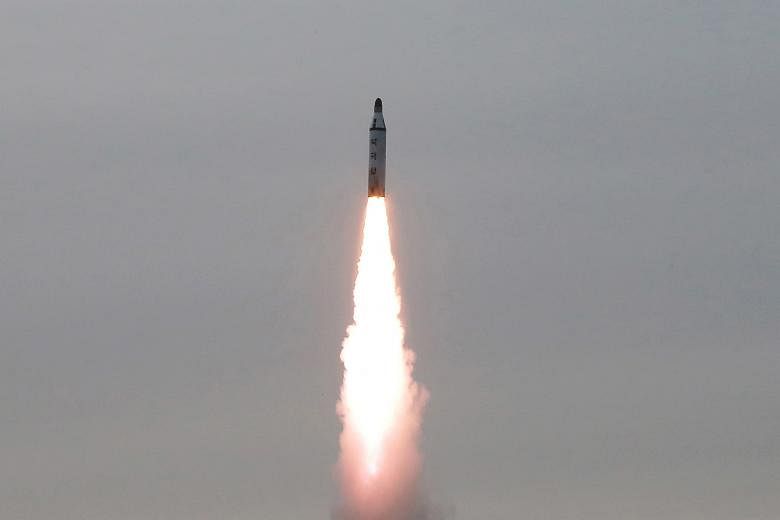SEOUL/WASHINGTON (AFP, REUTERS) - North Korea launched what appeared to be a second intermediate-range Musudan missile on Wednesday that flew about 400km, in what appeared to be its most effective test yet, hours after another launch failed, South Korea's military and the Pentagon said.
It was not immediately clear if the second Musudan launch, about two hours after the first, was considered a success or failure, or how the flight ended. However, the distance it covered was theoretically more than halfway towards the southwest coast of Japan's main Honshu island.
The missile reached an altitude of 1,000km, indicating North Korea had made progress in its missile programmes, Japan's Minister of Defence Nakatani said. "The threat to Japan is intensifying," he told reporters in Tokyo.
Gen Nakatani said North Korea's repeated missile launches were a "serious provocation" and could not be tolerated. But he said further provocation from Pyongyang could not be ruled out.
South Korea's presidential office said it will hold a national security meeting to discuss North Korea's latest missile launches.
The first missile was launched from the east coast city of Wonsan, a South Korean official said, the same area where previous tests of intermediate-range missiles were conducted, possibly using mobile launchers. Yonhap, quoting a government official, said it disintegrated mid-air after a flight of about 150km.
Pentagon spokesman Commander Gary Ross said in a statement the missiles flew over the Sea of Japan where they both fell, according to initial information.
The statement added that the first missile launch took place at 3:56pm CDT (4:56am Wednesday Singapore time) and the second one at 6:03pm CDT (7:03am Wednesday Singapore time) and neither missile posed a threat to North America.
The launches were in continued defiance of international warnings and a series of UN Security Council resolutions that ban the North from using ballistic missile technology, which Pyongyang rejects as an infringement of its sovereignty.
US State Department spokesman John Kirby condemned the launch, in a separate statement, and said the United States intended to "raise our concerns at the UN to bolster international resolve in holding the DPRK accountable for these provocative actions."
If confirmed, the failure would mark another setback for a weapons programme that ultimately aspires to develop a proven nuclear strike capability against the US mainland.
UN resolutions ban North Korea from any use of ballistic missile technology and, just hours before Wednesday's launch effort, the Pentagon had warned Pyongyang against pressing ahead with any missile test.
The North has made four previous failed attempts this year to test fly the Musudan, which has an estimated range of anywhere between 2,500 and 4,000 kilometres.
The lower range covers the whole of South Korea and Japan, while the upper range would include US military bases on Guam.
First unveiled as an indigenous missile at a military parade in Pyongyang in October 2010, the Musudan has never been successfully flight-tested.
Three failures in April were seen as an embarrassment for North Korea's leadership, coming ahead of a rare ruling party congress that was meant to celebrate the country's achievements.
Another attempt in May was also deemed to have failed.
Wednesday's effort came with military tensions still running high following Pyongyang's fourth nuclear test in January and a long-range rocket launch a month later that saw the UN Security Council impose its toughest sanctions to date on the North.
During the party congress in May, North Korean leader Kim Jong Un had personally extended an offer of military dialogue with the South.
The proposal was repeated several times by the North's military, but Seoul dismissed all the overtures as insincere "posturing" given Kim's vow at the same congress to push ahead with the country's nuclear weapons programme.
In recent months, North Korea has claimed a series of technical breakthroughs in developing an intercontinental ballistic missile (ICBM) capable of delivering a nuclear warhead to targets across the continental United States.
The claimed achievements included miniaturising a nuclear warhead to fit on a missile, developing a warhead that can withstand atmospheric re-entry and building a solid-fuel missile engine.
The North also hailed the successful test of an engine specifically designed for an ICBM that would "guarantee" an eventual nuclear strike on the US mainland.
Outside experts have treated a number of the claims with scepticism, while acknowledging that the North has made significant strides in upgrading its nuclear arsenal.

